Malvika Vaswani's jewellery a link to the past
Malvika Vaswani's jewellery, which combines an international aesthetic with local techniques, has been winning her clients and awards


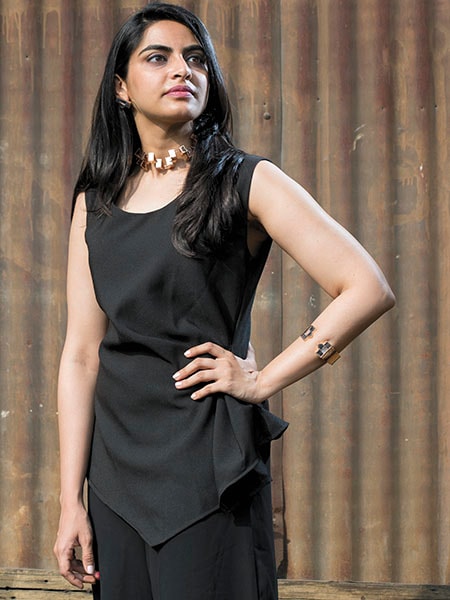
The love for working with different materials and techniques manages to find its way into Malvika Vaswani’s jewellery
Image: Joshua NavalkarWhen Malvika Vaswani, 27, was preparing her portfolio to go and study in the US, her goal was to gain entry into an architecture and interior design school. The idea of building something large-scale and concrete had always appealed to her. Though she opted for the interior design course at the prestigious Rhode Island School of Design (RISD), she soon realised industrial design was what she wanted to do—because of the scale and variety of materials she would be exposed to.
Though the niche she finally found for herself is a far cry from her large-scale aspirations, the rules of architecture and a love for working with different materials and techniques manage to find their way into her jewellery.
From her first collections, inspired by the Bauhaus movement and Islamic architecture in Andalusia and Spain, to her newest collections—Salt, drawn from the Art Deco and Art Nouveau movements, and Tsuru, which pays homage to Japanese woodworking techniques—Vaswani’s jewellery, based in metal, but also combined with different materials such as glass and cord, seems to have struck a chord.
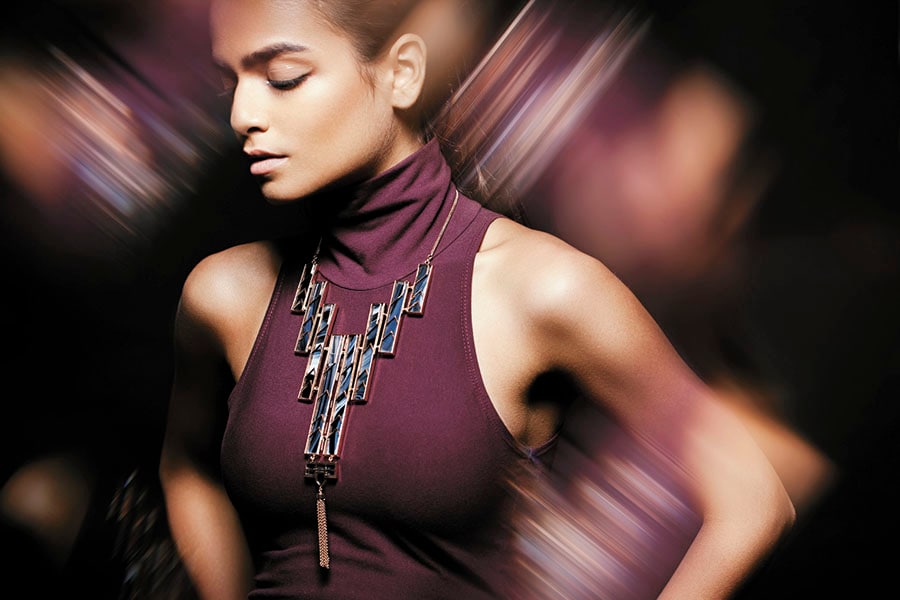
Drawing inspiration from stained glass windows found in chapels, the mosaic technique and iron grills, Vaswani’s latest collection, Salt, is inspired by the Art Deco and Art Nouveau movements. It embraces a fresh material in the form of stained glass, as an experiment with colour. The glass is enveloped in metal
Image: Parizad D Model: Chandni Sareen
“At RISD, I got to learn a lot about older techniques and manufacturing processes. I took to that very well as I had never had a chance to build and construct with my hands, understand materials and treat things accordingly. I enjoyed the exposure. I was always in the workshop and barely slept as making things with your hands takes much longer,” says Vaswani. She returned from the US and worked for a few architects and interior designers, including Mumbai-based architects Rooshad Shroff and Pinakin Patel, who is also a renowned interior designer.
At the same time, she had imbibed inputs from the environment she had grown up in—her father was involved in manufacturing processes and had a factory that made signage for highways, bus stops and petrol pumps, while her mother was trained in gemology and, on occasion, worked from home. 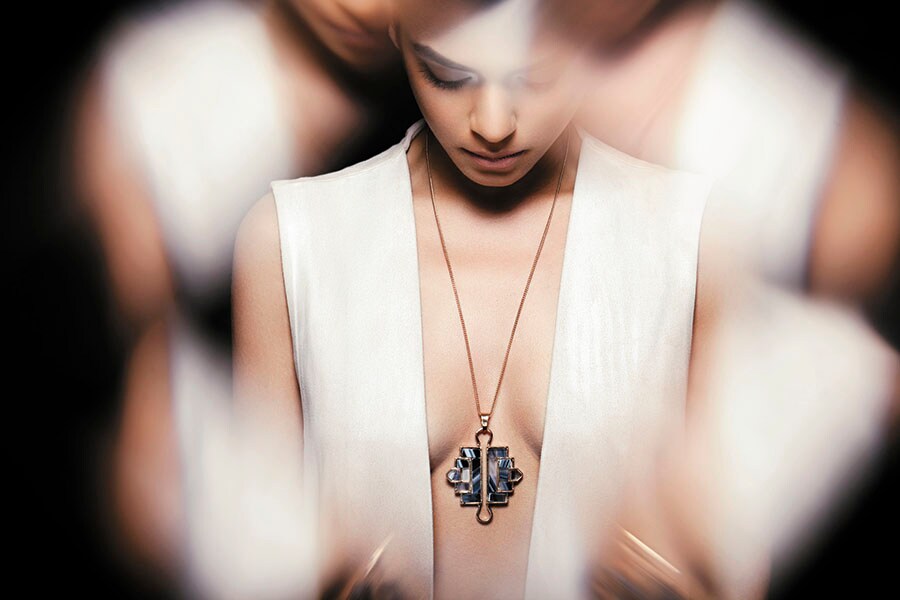 Glass encased in metal in a Salt collection piece
Glass encased in metal in a Salt collection piece
Image: Parizad D
All these influences came together after a chance encounter with a craftsman practising the bidri technique (a handicraft from Bidar, in Karnataka, and Andhra Pradesh, that uses blackened alloy of zinc and copper inlaid with thin sheets of silver) during one of her visits to the Paramparik Crafts Exhibition in Mumbai towards the end of 2011, and marked a turning point in her career. The contrasting finish caught her eye and her half-hour interaction with the craftsman exposed her to the reality of the dying craft. He almost pleaded with Vaswani to come up with designs that would make use of bidri, she recalls. “It almost felt like it was a responsibility he was handing over to me,” says Vaswani. She teamed up with a textile designer friend, Mallika Dalal, and they came up with a one-time jewellery line called Ore using cord and bidri. “We did this jewellery line with ten pieces and that is how things began for me.”
The label caught people’s attention for its unconventional approach to design. The duo went on to win an award at the India Design Forum (IDF) in 2013 and ended up supplying a limited stock to a few stores in India, like Ogaan in Delhi, Bombay Electric in Mumbai and Maison (now Indelust) in Bengaluru. The success provided Vaswani with the required impetus to quit her job with Pinakin Patel and start out on her own. She worked on a few freelance projects and, in September 2014, launched her eponymous jewellery design label. With brass with rose gold plating and black, her line was fresh and appealing. Her exhibitions were covered in leading
lifestyle magazines. 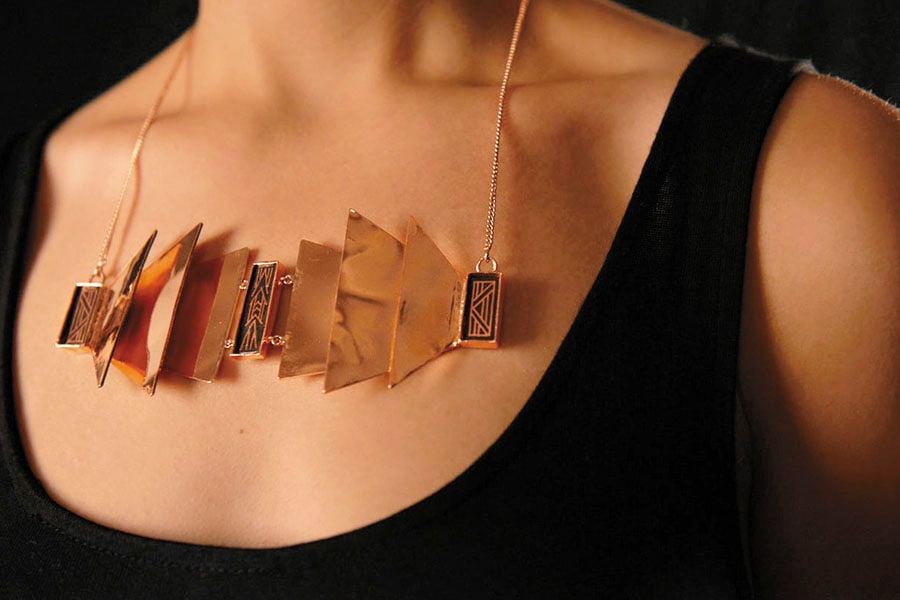 The Cordoba necklace from the Andalus collection created using the bidri technique
The Cordoba necklace from the Andalus collection created using the bidri technique
Image: Gary Taylor
Winning the Grazia Young Fashion Award (GYFA) in March 2015 “was like a tipping point for my label as it brought exposure from the media, people and stores to my label and to my aesthetic,” says Vaswani. Immediately after, she was selected for the Vogue Fashion Fund Award in the Accessories category, and was among the top three finalists. “2015 proved to be very good for me in terms of brand awareness and Grazia, for the first time, did a collaboration with Lakme Fashion Week for the GYFA winner’s fashion show. So that August, while the Vogue Fashion Fund was on, I even showcased at Lakme Fashion Week,” she adds.
A membership with the Fashion Design Council of India, a collaboration with fashion designers Urvashi Kaur and Neeta Lulla in March 2016, and a series of exhibitions in Mumbai and Delhi followed. “I did a few independent pop-ups for stores and participated in larger B2B exhibitions,” she says.
The use of rose gold is almost always a constant in Vaswani’s work and all of it retains the three Ms of her label—monochrome, metallic and minimalism. But while keeping the core concept intact, she reinvents herself too. She has a rigorous process—she reads up on a subject, does visual research and then creates sketches. “After that, I make mock-ups in different materials (paper, cardboard and clay) to understand scale and personal interactions and finally in metal. As you interact with materials, you improvise on the designs. If they turn out the way I have envisioned them, we go on to make them in a limited quantity—about four to five pieces the first time.” She increases production on the basis of demand. 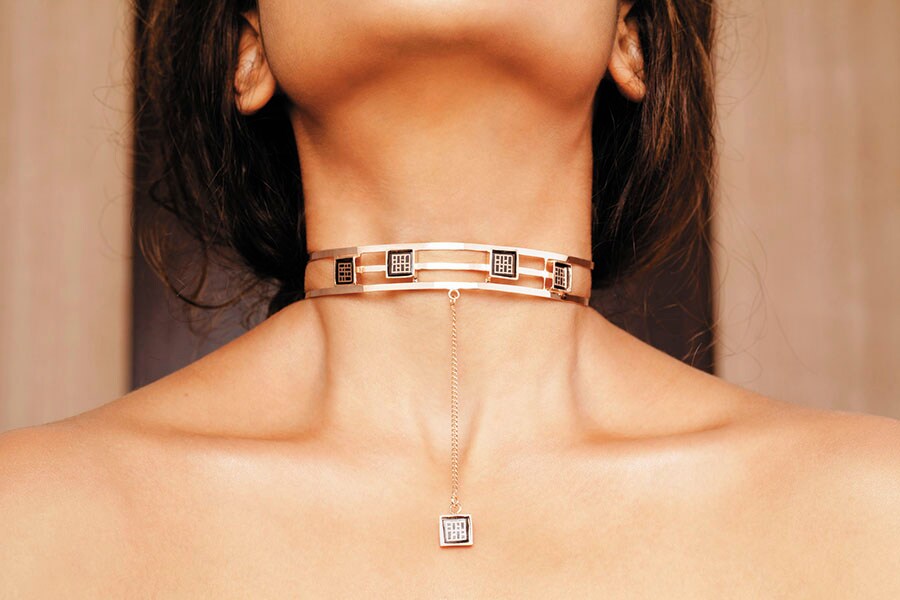 A rod and bidri choker from one of her latest collections, Tsuru, which is inspired by Japanese woodwork techniquesImage: Parizad D
A rod and bidri choker from one of her latest collections, Tsuru, which is inspired by Japanese woodwork techniquesImage: Parizad D
In 2011, when she returned from the US after her degree from RISD and two short stints in New York—with Terbbiano, designing jewellery for BCBGeneration, and tableware for Teroforma, a home decor company—Vaswani was not clear about what she wanted to do. “At 22, I was all over the place. I knew that I’d like to work in this space, but I did not have an agenda. I moved back to India because I knew this is where I wanted to be.” Now, she is clear about the direction she is taking. A firm believer in sharing knowledge, she teaches at the Indian School of Design & Innovation, the Parsons affiliation in Mumbai. “This is one way to impart whatever I have learnt in the hope that they will take it forward. The more you share, the more ideas [you get],” she says.
There’s also the desire to keep homegrown traditions alive. “I want to be one of the people pushing the boundaries and notions of design. I want to design for a social cause. I started doing jewellery thinking about the revival of handicrafts. That is something I keep consistent in my line.”
First Published: Dec 03, 2016, 07:02
Subscribe Now